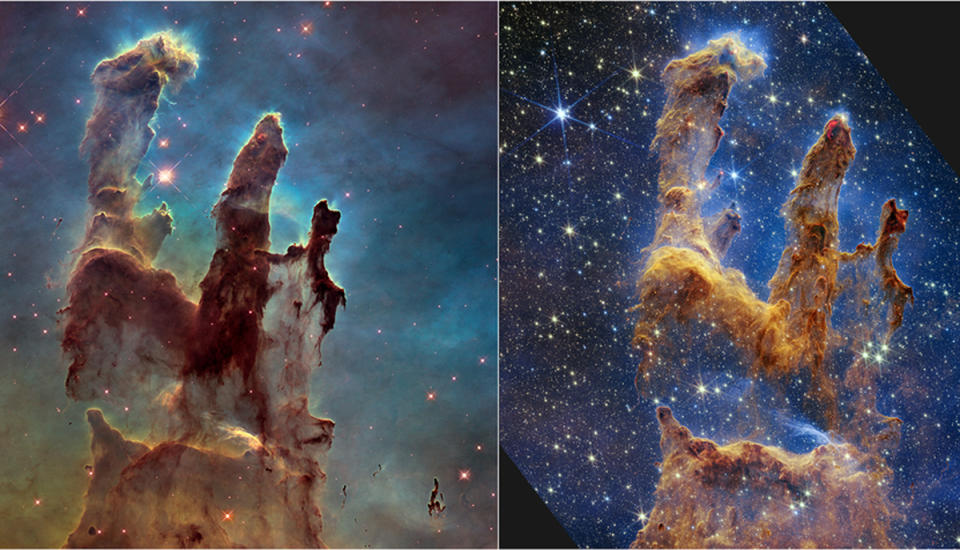NASA’s James Webb Space Telescope (JWST) is known for capturing our universe with unprecedented sensitivity and sensitivity. His images are not only scientifically useful but also beautiful. Of blue and gold Southern Ring Nebula pink, orange and purple Cassiopeia A.JWST images show the universe in bright colors.
The images are so impressive that you may wonder: Do these cosmic objects really look this colorful? What would they look like if we could see them with our own eyes instead of through a telescope?
“The quickest answer is we don’t know,” said Alyssa Pagan, a science images developer at the Space Telescope Science Institute (STScI) and part of the team working to add color to the JWST images. But one thing is certain: You can’t see the universe that way.
JWST is an infrared telescope, meaning it “looks” at the universe at wavelengths of light longer than red light, which is the longest wavelength we can detect with our eyes.
Relating to: How will the James Webb Space Telescope’s infrared detectors open new horizons in astronomy?
If you could look directly at these objects, you might see something closer to images from telescopes that rely on visual light. Hubble space telescope, Pagan said. But even this comparison is not quite accurate because Hubble is much larger and more sensitive than the human eye. Additionally, visual light telescopes can capture different characteristics of an image than an infrared telescope, even when focused on the same target.
So how are the colors of these magnificent images chosen? JWST targets are viewed through various filters attached to the telescope that “see” within a specific wavelength range of infrared light. The telescope’s main camera, JWST’s Near Infrared Camera, has six filters, each capturing slightly different images. Combining these images into a composite allows Pagan and Joe DePasquale, another science image developer at STScI for JWST, to create full-color images.
When Pagan and DePasquale first receive the images, they appear to be in black and white. Pagan explained that colors are then added to the image by converting data from various filters into the visible light spectrum. The longest wavelengths appear red, while shorter wavelengths appear blue or violet.
“We’re using this relationship with the wavelengths and color of light and just applying it to the infrared,” Pagan said.
Each color may undergo some additional changes after it is added to the image. Sometimes the original colors can cause the image to appear washed out or dusty, and the colors are made more vibrant to provide a sharper quality. Colors can also be shifted to highlight certain hard-to-detect features.
Pagan and DePasquale also said they worked with researchers to make sure the images were scientifically accurate, especially when presented in conjunction with a specific scientific finding. Although color images do not provide specific scientific data, they can help explain certain findings.
Sometimes it can also help scientists see areas they might want to investigate, Pagan said. For example, the most distant objects First deep field view of JWST Objects that appear red because the light that travels such a distance is elongated offered targets for studies of the early universe, where these objects existed as they appear in the deep-field image.
The colors in JWST images may not be “real” but don’t get the wrong idea; The colors are not designed to fool you and they are not chosen just to look good. The images are intended to convey as clearly as possible what JWST can see and what our eyes cannot.
“We’re just trying to improve some things to make it more scientifically digestible and also interesting,” Pagan said.

By comparing images of the iconic galaxy, you can see some of the differences between images taken from visual light and infrared telescopes. Pillars of Creation Taken by JWST and Hubble. While most of the pillars appear dark red in the Hubble image, most of the formation is depicted in shades of gold and orange in the JWST image. This means that the visual light emitted by the pillars has a longer wavelength (red) but is slightly closer to the middle of the infrared light spectrum shown in the image.
Much of the hazy material surrounding the pillars in the Hubble image, and even some of the material of the pillars themselves, is also missing from the JWST image; This means that this part of the gas and dust is transparent in the infrared. The JWST image also highlights in red more star-forming areas obscured by thick clouds of gas and dust in the Hubble image.